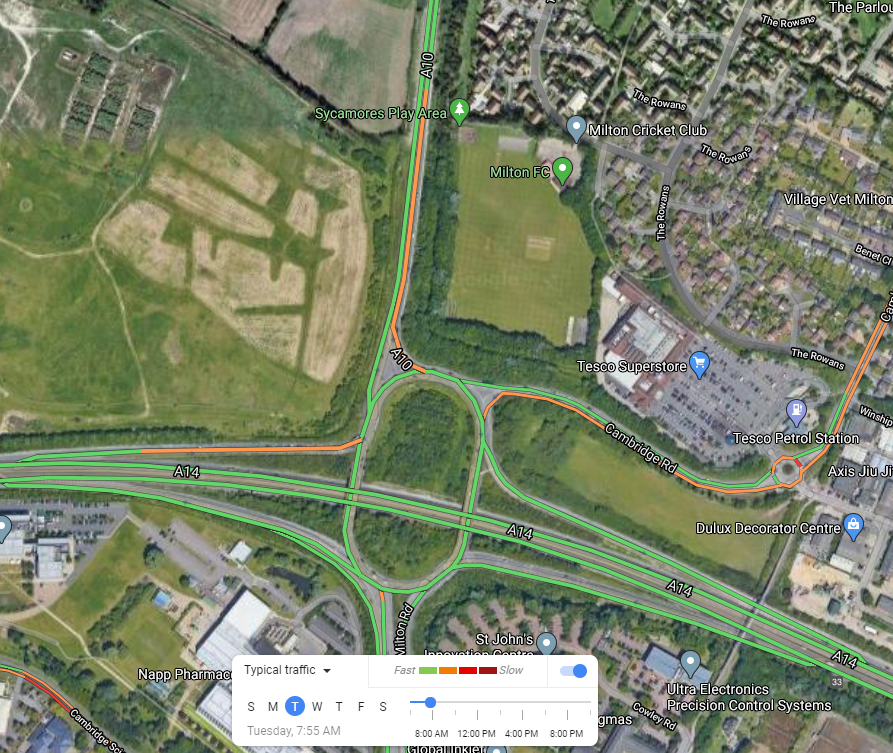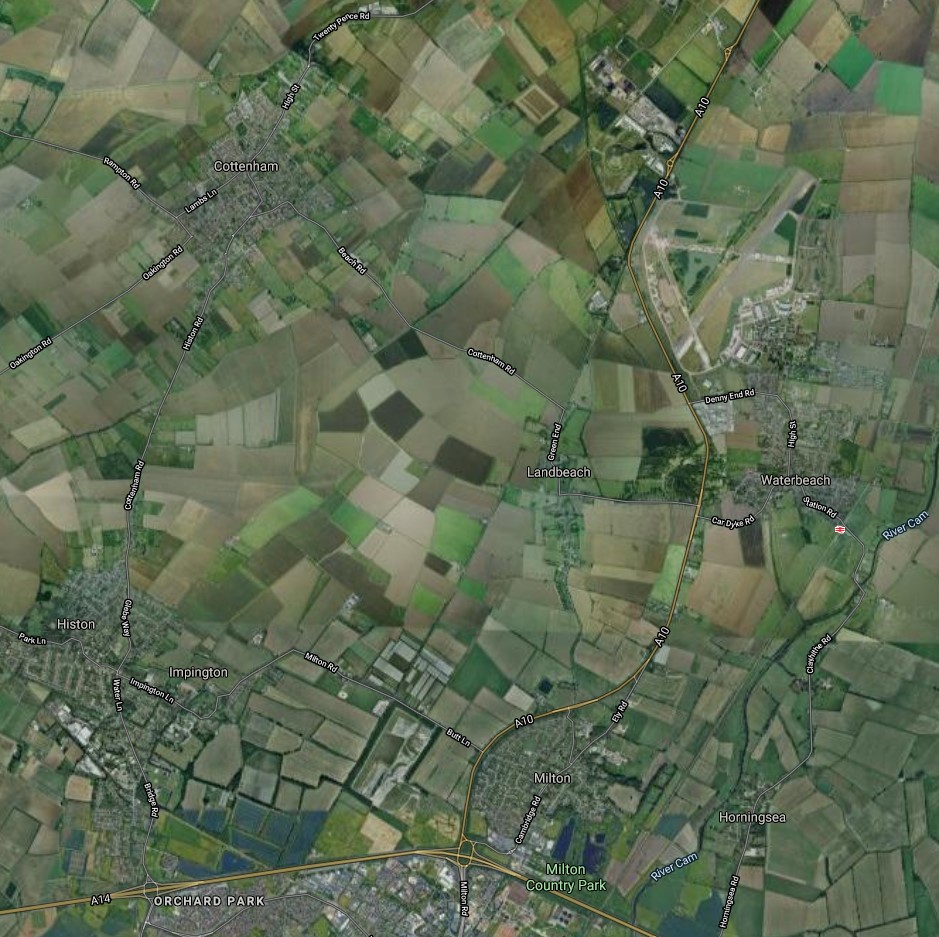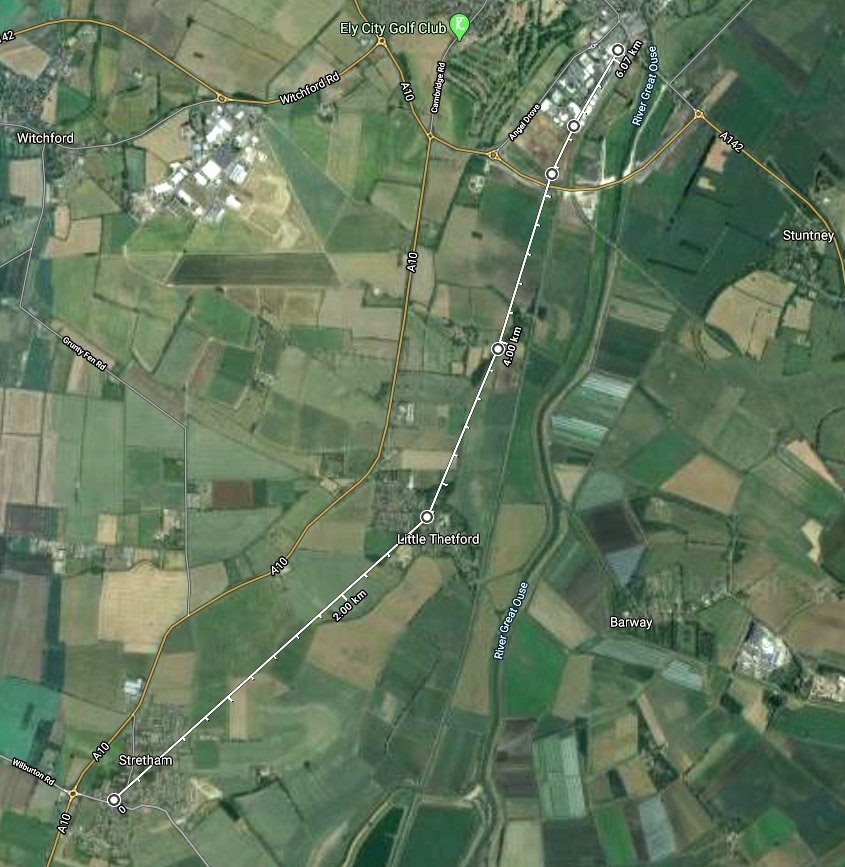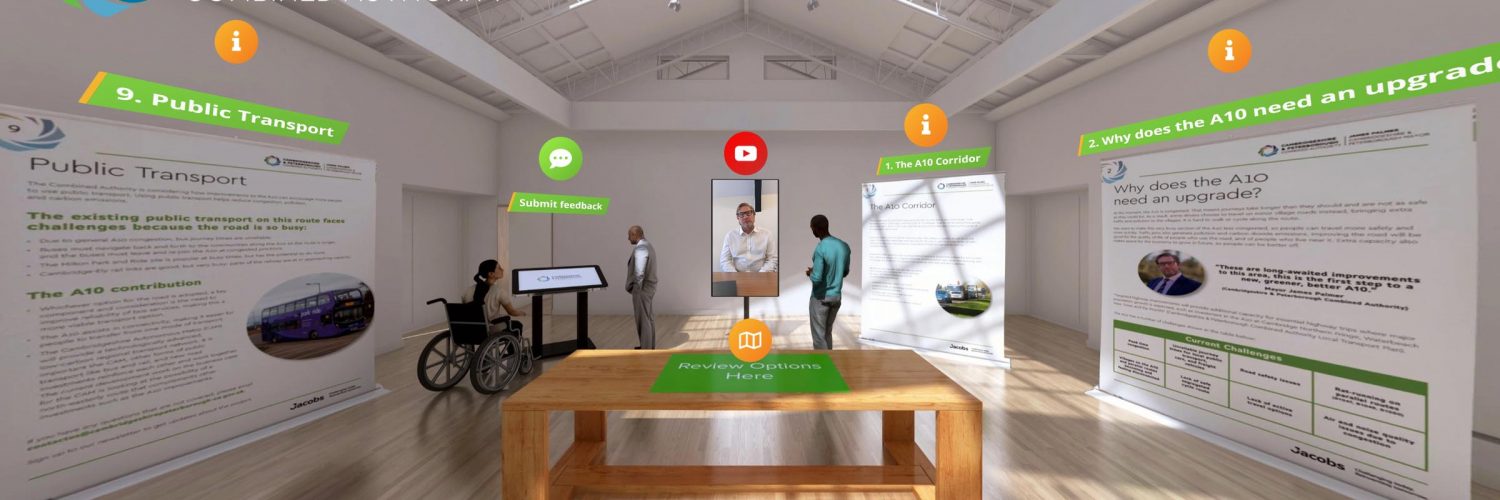
Here are some thoughts intended to help people respond to the consultation:
In the context of a climate and ecological emergency, building and upgrading roads must be considered as a last resort, when all other options to increase capacity (in terms of moving more people and freight) and improve safety have been exhausted. There is large potential in getting more people using the railway and cycling. Waterbeach to the Science Park or Stretham to Ely station are both under 4 miles or 20–30 minutes by bike.
The pressing needs are for protected cycleways and better bus connections to railway stations. Compared with adding lanes to a road, shifting trips from solo car journeys to walking, cycling, car-sharing, bus and train increases capacity more effectively, at lower cost, lower environmental impact and with significant public health benefits.
Let’s look at the justifications used for dualling the A10:

Point 1: more room to queue
“More room for traffic” = More room for traffic to queue
The capacity of a road is determined by the rate at which vehicles can leave it, not the speed at which they can travel between junctions. The main constraint for the A10 southbound in the morning peak is the Milton Interchange. Queues on the A10 exist now because the rate of arrivals at the interchange exceeds the rate at which they can enter Cambridge or join the A14.

There is already 280m of two-lane carriageway entering the interchange. That’s more than can clear in a single cycle of the traffic lights. Therefore, extending the dual carriageway will make no difference at all to queuing times.
Northbound in the evening peak, the main area of congestion is around the roundabouts south-west of Ely, where the A10 and A142 share 700m of single-carriageway. Environmental concerns aside, simply adding a northbound lane between the two roundabouts would reduce delays.

Congestion is also experienced around other junctions, notably where the A1123 crosses the A10 at Stretham and at Denny End Rd. If it is feasible and cost-effective to increase the capacity and safety of these junctions without simply displacing queues, then it makes sense to do so. This makes consultation Option G the most appropriate choice:

Point 2: more space?
“creating more space for volume to spread out over peak times”
It’s hard to make any sense of this. If traffic queues in two lanes rather than one, it is less spread out, not more.
Point 3: cycleways
“allowing for a dedicated cycle path”
The connection is tenuous: dualling a road does not by itself create space for a protected cycleway; rather, it is re-routing where the width is constrained, e.g. through Stretham, that creates the opportunity.
However, the route of a cycleway should be determined by what will make it safe (in reality and perception), direct and attractive. It should not simply be bolted onto a road project for convenience. Most importantly, the merits of building a cycleway stand on their own. There is never a justification for making investment in cycling dependent on a road scheme.
The £260 million the Combined Authority has requested to dual about 20km of road would buy around 500km of off-road or protected cycleway (based on Cambridgeshire County Council’s figures).
Point 4: hold-ups
“Allows for overtaking of slow agricultural and freight traffic”
This does not require end-to-end dualling. Passing lanes and new farm tracks could solve this problem at relatively low cost and environmental impact.
Point 5: congestion
“increasing the flow of traffic, and reducing congestion”
As discussed above, increasing flow into a junction like the Milton Interchange, increases, not decreases, congestion.
Point 6: safety
“Central reservation between opposing flows of traffic [decreases] risk of head on collision”
Whilst this is true, junctions on dual carriageways are typically more hazardous than on single carriageway roads, especially for pedestrians, cyclists and horse riders.
Point 7: Cambridgeshire Autonomous Metro (CAM)
“It is important the CAM, other forms of public transport like bus and rail, and new road investments reinforce each other and work together.”
This is incoherent: if investment in the A10 were to make journey times faster by car, it would reduce demand for public transport, and hence undermine investment in CAM and the existing railway. Creating competing transport infrastructure is wasteful.
For Waterbeach and Ely, the railway can provide the best connectivity to Cambridge (and other destinations). The best strategy is to invest in cycleways and bus services to facilitate access to rail services. This will ensure as many people as possible can benefit from the huge investment in the railway: the new Waterbeach station (expected to open in 2021), Cambridge South station (expected to open in 2025), and other investments to enable more services to run.
Our recommended priorities
The best way to reduce congestion is to reduce demand to drive at peak times by shifting driver-only car trips to rail, bus, car-share, cycle and home-working. With these options, environmental, social and economic objectives all align, largely avoiding the need for trade-offs.
We believe the priorities now should be:
1) Build protected cycleways
North of Cambridge, off-road cycleways are needed to link Cottenham, Histon & Impington, Landbeach, Waterbeach and Milton. These villages are all within a comfortable cycling distance of each other. These will complement existing cycleways into Cambridge from Histon and Milton, and planned cycleways from Waterbeach.

South of Ely, a cycleway linking Stretham, Little Thetford and Ely via the railway station is needed as part of a wider network of cycleways connecting Ely with surrounding villages. The distance from Stretham to Ely is under four miles, a comfortable cycling distance.

2) Improve bus services
Invest in bus services to connect Ely, Waterbeach and Cambridge North railway stations with their surroundings. Ensure that as many people as possible are able to benefit from investment in rail stations and services over the coming decades.
3) Build a bus bypass at the A14
Build a bus-only link between Milton Park & Ride and the A14 underpass behind Cambridge Regional College to enable Park & Ride and express buses from Ely to bypass the Milton Interchange.

4) Make localised A10 improvements
Identify which junctions and stretches of road could be reconfigured or upgraded to improve safety, reduce conflicts with agricultural traffic and give buses priority over general traffic.
For any capacity increases considered, conduct careful analysis of side effects: queue displacement, induced demand, reduced demand for public transport, environmental damage, social isolation of those without access to a car, reduced public health from inactivity, etc.



I agree that the cycle route from Stretham to (Ely centre and) Ely Railway Station needs to be mentioned.
However the potential for cycle journeys between Sutton and Witchford (including Lancaster Way business park) is greater and will being strangled by the imminent changes at the A10/Witchford Road (BP Garage) roundabout, with no remedy included in the A10 improvement plan, despite a commitment in the Local Transport Plan para 3.140.
Probably not under the remit of this A10 upgrade is active travel between other outlying villages and Ely Railway Station (Lt Downham, Littleport and Stuntney).
Definitely in scope is the need to provide for active travel for all the villages along the A10 corridor, not just Stretham (where I live) and Lt Thetford. Electrically-assisted machines with speed limitation such as EPACs will undoubtedly make trips of more than 5 miles acceptable for the general public. A cycle route between Cambridge and Ely is already planned (CCC Transport Investment Plan) and as you point out, such routes should be considered independent of any changes to the A10 for motor vehicles. The additional places such a route needs to link are Stretham, Denny Lodge and Cambridge Research Parks, Landbeach and Waterbeach. There are a couple of cyclists who brave the A10 Stretham to Waterbeach now and I’m sure there is suppressed demand.
Ooh, I forgot to mention Waterbeach New Town as a point on a cycle route between Ely and Cambridge.
We’re now entering the “new normal” post-covid19 world. Many businesses have discovered that physical offices aren’t as important as they wanted and many people can work from home effectively.
Many Cambridge villages have patchy broadband and mobile coverage, so how about making it easier to work from home and reduce commuting by fixing the infrastructure?
We need smaller more regular buses covering more routes, these should be electric too. The problem with park and ride is you still have people driving at all.
Car sharing and multiple occupancy vehicle lanes should be considered. How about if a car has three or more people it can use a bus lane? Why is a taxi with one passenger allowed in the bus lane, it’s just the same as a private car with just a driver?!
It’s very simple, and I don’t understand why you don’t get it. We are in the middle of a climate emergency and need to stop building new roads and extending existing ones. The money should be spent on cycling, public transport and broadband infrastructure for people to work from home whenever possible. If we don’t make all possible efforts to reduce emissions this century is going to be absolutely catastrophic, with temperature rises of 4 degrees leading to mass starvation and war, and our children and grandchildren will curse us for our selfishness and inaction. Is that really what you want?
Be sure to make this point to the Combined Authority via the consultation feedback form (by 5pm on Tuesday 14 July).
Very good point. I’ve noticed that there are only about 4 cars at the station car park every day as opposed to being full, with cars parked on the verge and all along Station road now. So people are working from home and it seems will continue to do so.
Can I still comment on the A10 upgrade?
The consultation has closed, but you can still email the Combined Authority at a10@cambridgeshirepeterborough-ca.gov.uk.
Creating bus ways is great but tickets are to expensive and buses are inefficient and take way to long. Bus travel works great in big cities but in rural locations it’s inefficient and cars are the only real option.
Agree with David Carter and Aaron – there should be more focus to make public transport more attractive to commuters, currently I see no benefits on taking bus while travelling from Little Thetford to Cambridge:
– I’m stuck in traffic on A10 is the bus as I would in my car
– Ticket prices putting me off, £7.00 one way for 11 miles journey is an absolutely rip-off, overall (petrol, insurance, MOT and Tax) is cheaper to travel by car
– Unreliable service (very unreliable: busses are late, sometimes not arriving at all)
– Outdated vehicles: dirty, old, not comfortable
How to improve it? Simple:
– dual A10 from Ely to Cambridge, but make that additional lane for buses only (busses no longer will be a part of traffic, hence will arrive on time and will attract more commuters and reduce numbers of vehicles)
– more commuters = more business for bus operators: reduce ticket prices, increase service
– over time replace fleet with XXI century electric and modern vehicles
I would also pursuit creating more off-road cycle laces linking Ely – Little Thetford – Stretham – Waterbeach – Cambridge.